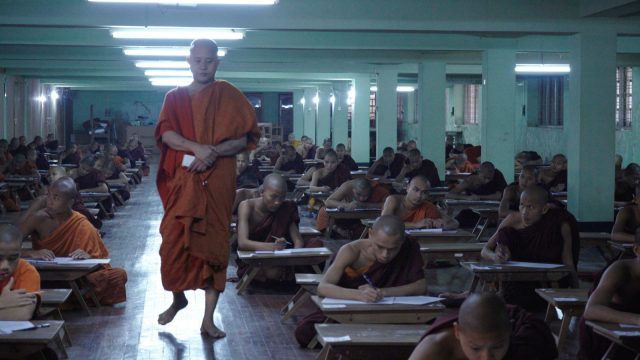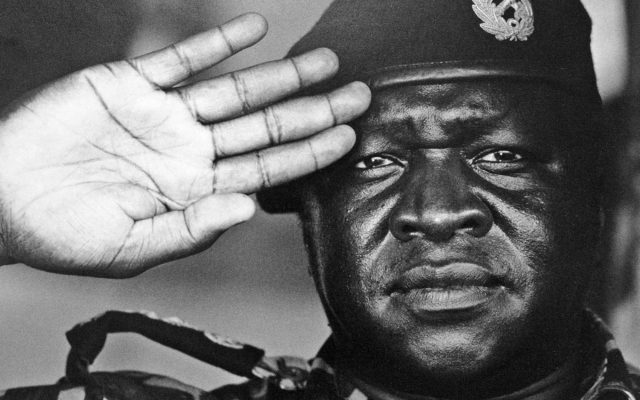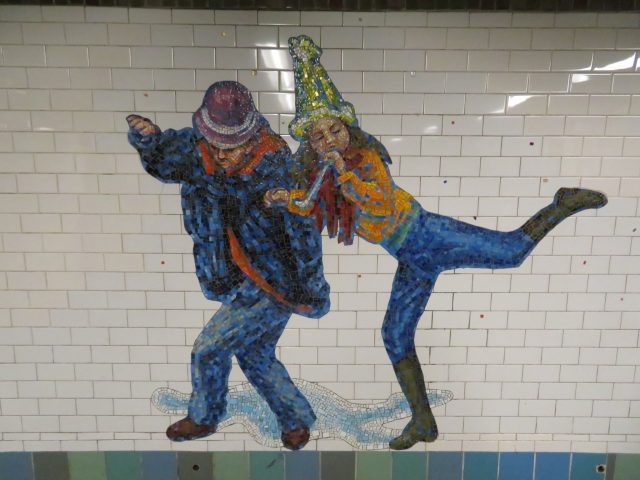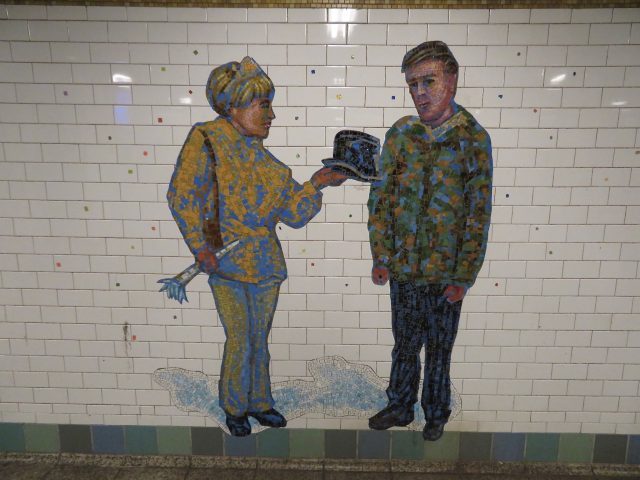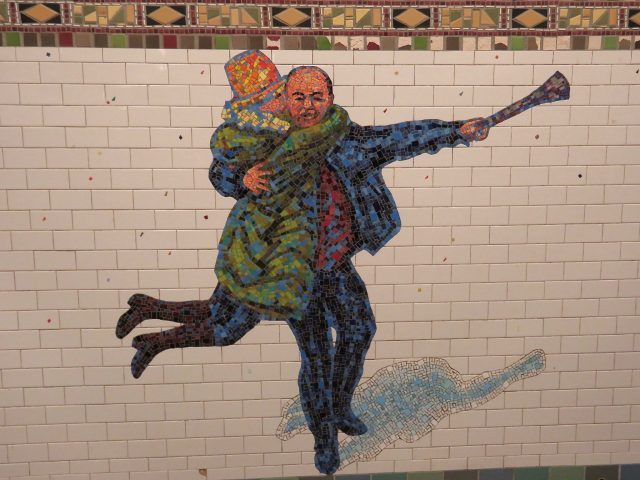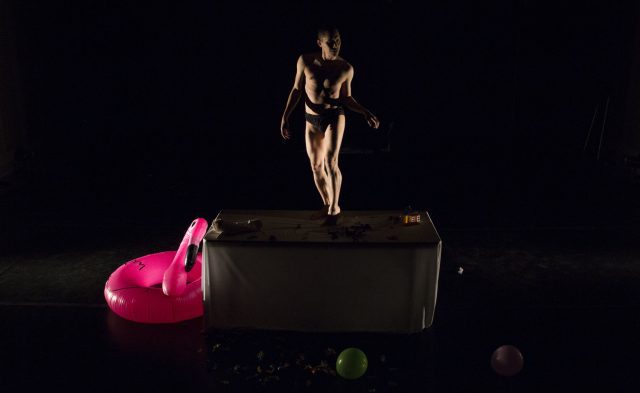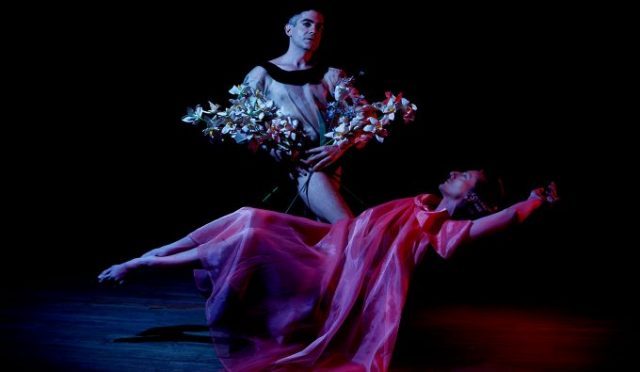
Jack Ferver collaborates with Reid Bartelme as well as James Whiteside, Lloyd Knight, and Garen Scribner in the world premiere of Everything Is Imaginable at New York Live Arts (photo by Jason Akira Somma)
New York Live Arts
219 West 19th St. between Seventh & Eighth Aves.
January 7-12, $15-$35, 8:00 or 10:00
212-924-0077
americanrealness.com
newyorklivearts.org
Jack Ferver’s Everything Is Imaginable returns this week to New York Live Arts as part of the multidisciplinary American Realness festival. Below is our review of the work’s world premiere in April 2018; don’t miss this second chance to catch this extraordinary piece.
A few weeks before the world premiere of Everything Is Imaginable, New York City treasure Jack Ferver tore his calf while preparing a piece for Reid Bartelme and Harriet Jung at the Guggenheim. But leave it to the Wisconsin-born actor, writer, dancer, choreographer, teacher, and director to incorporate the injury into the narrative of the two-act, seventy-minute show. As the audience enters the theater at New York Live Arts, the curtain is down, a rarity at the venue, upping the growing sense of anticipation that accompanies every Ferver work. The curtain soon opens on Jeremy Jacob’s playful set, consisting of four white cardboard columns with drawings of leaves on them, along with a central cardboard chandelier hovering at the top of a screen in the back. It immediately immerses the crowd into the wonders of Ferver’s imagination while exposing the artifice behind staged productions in general. The first act features four queer men in sheer, butt-revealing outfits dancing solos inspired by their childhood memories and one major role model: American Ballet Theater principal James Whiteside, in a short, glittering dress of silver sequins, pays tribute to Judy Garland, dancing to Garland’s version of Cole Porter’s “I Happen to Like New York”; Martha Graham principal dancer Lloyd Knight honors Graham, moving to a recording of the legendary choreographer speaking about dance; dancer and actor Garen Scribner slides across the stage in socks and does spins like his hero, champion skater Brian Boitano, to the sound of ice skates being sharpened and gliding across the ice; and longtime Ferver collaborator Bartelme, a former ballet dancer and current costume designer (as part of Reid and Harriet Design, who made the costumes for the show), wears a long orange mane and dances with horse movements, since his idol is My Little Pony. Each solo combines humor with beautiful movement, taking advantage of each dancer’s strengths while adding the charm and whimsy that are mainstays of Ferver’s choreography. The four star turns are followed by a solo about sunglasses and then an ensemble piece danced to “club music,” including a Martha Graham–esque sexualized orgy that is uproariously funny.
After a ten-minute intermission (with the curtains closed), the second act begins with Ferver (Chambre, Night Light Bright Light) by himself onstage, standing over a miniature version of the set from the first act, evoking Stonehenge from This Is Spinal Tap. In a sheer bodysuit recalling Michelle Pfeiffer’s garb as Catwoman in Batman Returns, the compact Ferver towers over the tiny columns and chandelier, emphasizing his power as a creator while also poking fun at it. Ferver talks about his calf injury, explaining how that limited his ability to dance — his doctor advised him not to move forward, which is not part of his vocabulary, literally or figuratively — and forced him to reimagine the work, and discusses his difficult childhood, friendless and bullied for his overt homosexuality; growing up gay is a regular theme in his oeuvre. As always, his stage persona is that of a devilish cherub, wild and wacky one moment, making the audience roll around their seats with laughter, and then deadly serious the next, raising disturbing elements from his life that may or may not be true, causing everyone to reconsider their reactions. He’s joined by Bartelme, who looks lovely in a fringe dress, and the two dance together to heartbreaking effect while Ferver, soldiering on despite his injury, goes on to describe his process of writing a memoir, which took place alone, terrified, in a strange house, in the dark. Ferver is no longer friendless or alone, as evidenced not only by the crowd response to the supremely personal show but by the long line of well-wishers who waited to hug and congratulate him for giving them yet another unique, meaningful, and vastly entertaining experience, shining a light on his life, and ours, as only he can.
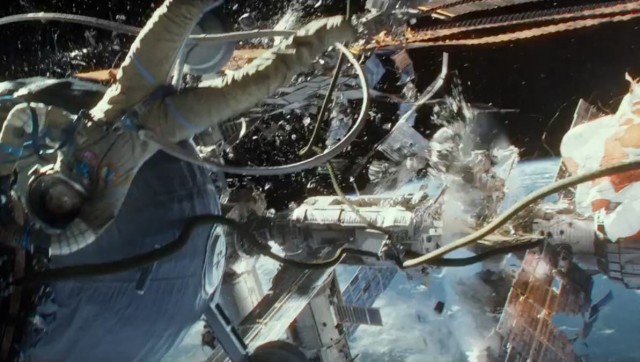
 Alfonso Cuarón’s Gravity is a breathtaking thriller that instantly enters the pantheon of such classic space fare as 2001: A Space Odyssey, Alien, and The Right Stuff. While medical engineer Dr. Ryan Stone (Sandra Bullock) is fixing a computer glitch outside the shuttle Explorer, veteran astronaut and wisecracker Matt Kowalski (George Clooney), on his final mission before retirement, is playing around with a new jetpack and Shariff (voiced by Paul Sharma) is having fun going on a brief spacewalk. But disaster strikes when debris from a destroyed Russian satellite suddenly comes their way, killing Shariff and the rest of the crew and crippling the shuttle, leaving Stone and Kowalski on their own in deep space, their communication with Mission Control in Houston (voiced by Ed Harris, in a nod to his participation in Apollo 13 and The Right Stuff) gone as well. Kowalski is cool and calm, listening to country music as he tries to come up with a plan that will get them to the International Space Station, but the inexperienced Stone is running out of oxygen fast as she tumbles through the emptiness, Earth in the background, so close yet so far. Written by Cuarón (Y Tu Mamá También, Children of Men) with his son Jonás, Gravity is spectacularly photographed by Emmanuel Lubezki, the master behind numerous works by Cuarón and Terrence Malick (The New World, The Tree of Life), among others. Lubezki and his team even created a new LED light box to increase the film’s realism, which is nothing less than awe-inspiring and mind-bending as it takes place in real time. Despite the vastness of space, Gravity often feels claustrophobic, particularly as Stone struggles to get a breath or attempts to operate a foreign module.
Alfonso Cuarón’s Gravity is a breathtaking thriller that instantly enters the pantheon of such classic space fare as 2001: A Space Odyssey, Alien, and The Right Stuff. While medical engineer Dr. Ryan Stone (Sandra Bullock) is fixing a computer glitch outside the shuttle Explorer, veteran astronaut and wisecracker Matt Kowalski (George Clooney), on his final mission before retirement, is playing around with a new jetpack and Shariff (voiced by Paul Sharma) is having fun going on a brief spacewalk. But disaster strikes when debris from a destroyed Russian satellite suddenly comes their way, killing Shariff and the rest of the crew and crippling the shuttle, leaving Stone and Kowalski on their own in deep space, their communication with Mission Control in Houston (voiced by Ed Harris, in a nod to his participation in Apollo 13 and The Right Stuff) gone as well. Kowalski is cool and calm, listening to country music as he tries to come up with a plan that will get them to the International Space Station, but the inexperienced Stone is running out of oxygen fast as she tumbles through the emptiness, Earth in the background, so close yet so far. Written by Cuarón (Y Tu Mamá También, Children of Men) with his son Jonás, Gravity is spectacularly photographed by Emmanuel Lubezki, the master behind numerous works by Cuarón and Terrence Malick (The New World, The Tree of Life), among others. Lubezki and his team even created a new LED light box to increase the film’s realism, which is nothing less than awe-inspiring and mind-bending as it takes place in real time. Despite the vastness of space, Gravity often feels claustrophobic, particularly as Stone struggles to get a breath or attempts to operate a foreign module. 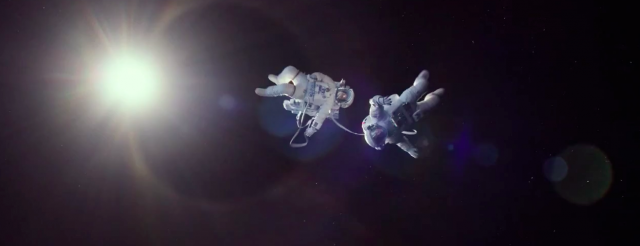
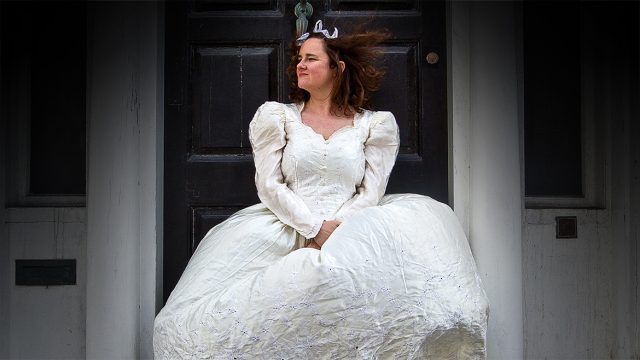
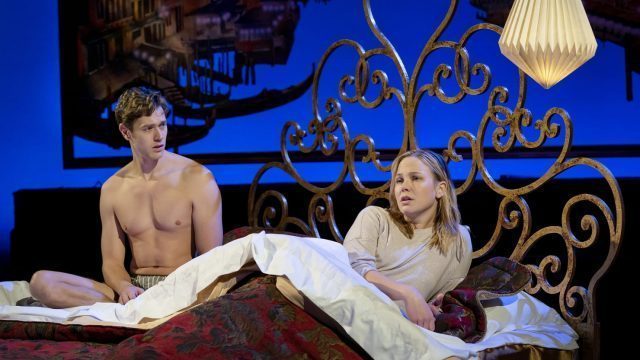
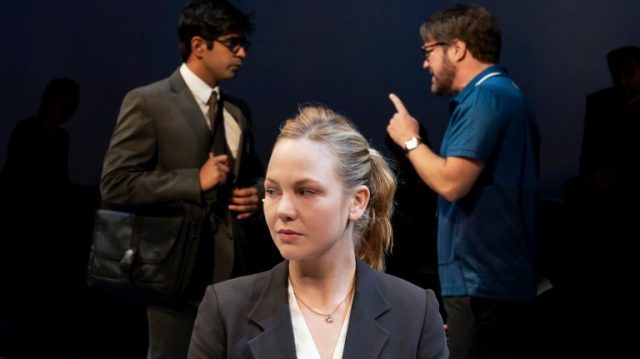
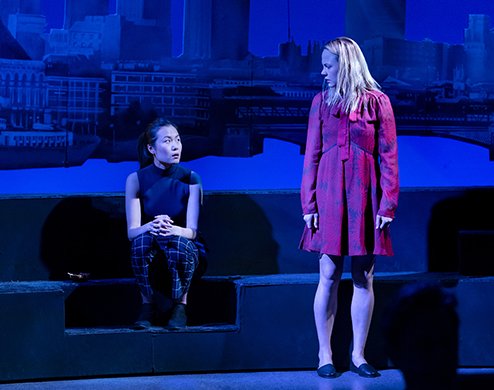
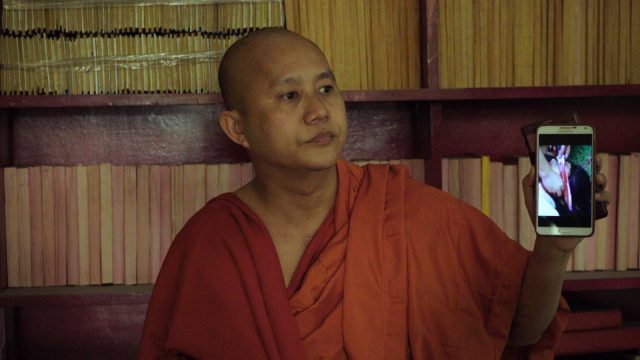
 “To Save and Project: The 16th MoMA International Festival of Film Preservation,” comprising newly restored and preserved works from throughout the history of cinema, kicks off January 4 with a tribute to Iranian-born Swiss-French director Barbet Schroeder’s self-described “trilogy of evil”: 1974’s Général Idi Amin Dada: Autoportrait (General Idi Amin Dada: A Self Portrait), about the Ugandan dictator; 2007’s L’avocat de la terreur (Terror’s Advocate), a portrait of Siamese-born French lawyer Jacques Vergès, who has defended such clients as Klaus Barbie, French philosopher and Holocaust denier Roger Garaudy, and Carlos the Jackal; and last year’s Le vénérable W. (The Venerable W.), a look at controversial Buddhist monk Ashin Wirathu. According to long-standing traditions and beliefs, Buddhists have empathy and compassion for all sentient beings. For example, in the 2017 documentary
“To Save and Project: The 16th MoMA International Festival of Film Preservation,” comprising newly restored and preserved works from throughout the history of cinema, kicks off January 4 with a tribute to Iranian-born Swiss-French director Barbet Schroeder’s self-described “trilogy of evil”: 1974’s Général Idi Amin Dada: Autoportrait (General Idi Amin Dada: A Self Portrait), about the Ugandan dictator; 2007’s L’avocat de la terreur (Terror’s Advocate), a portrait of Siamese-born French lawyer Jacques Vergès, who has defended such clients as Klaus Barbie, French philosopher and Holocaust denier Roger Garaudy, and Carlos the Jackal; and last year’s Le vénérable W. (The Venerable W.), a look at controversial Buddhist monk Ashin Wirathu. According to long-standing traditions and beliefs, Buddhists have empathy and compassion for all sentient beings. For example, in the 2017 documentary 